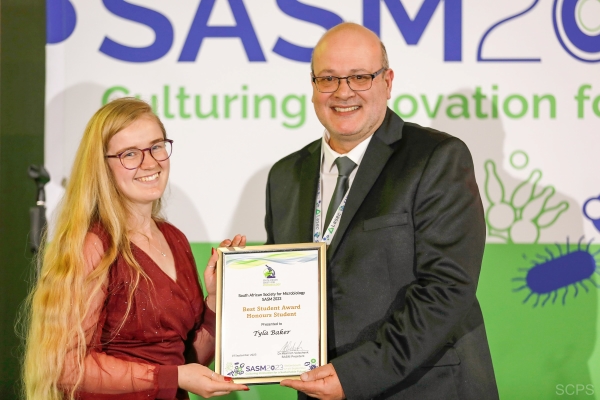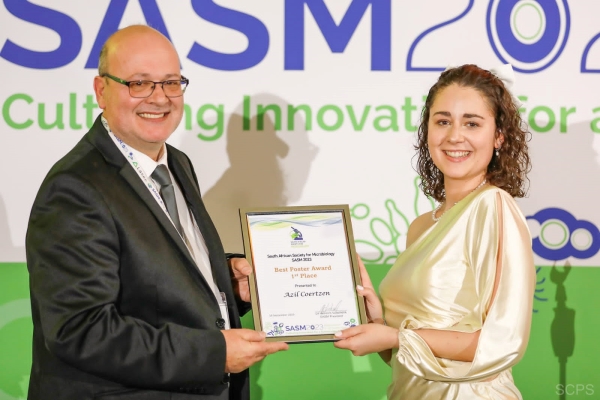Three postgraduate students in the Department of Microbiology and Biochemistry at the University of the Free State (UFS) were honoured with awards for their research at the recently concluded Biennial Congress of the South African Society for Microbiology (SASM) in Stellenbosch.
Samantha Mc Carlie, a PhD candidate, was awarded the prestigious SASM bronze medal for publishing in an outstanding publication, while Azil Coertzen, a first-year master's student, won the prize for the best poster presentation at the congress for her work on infectious coryza. Tyla Baker, who is currently studying towards her MSc degree in Microbiology under the supervision Prof Carlien Pohl-Albertyn, National Research Forum (NRF) SARChI Research Chair in Pathogenic Yeasts, won the prize for the best BSc honours student.
Both Mc Carlie and Coertzen are students of Prof Robert Bragg’s Infection Control Group within the Veterinary Biotechnology Research Group, Department of Microbiology and Biochemistry. He is also their supervisor.
Source of motivation
“I am very excited and honoured to have received this award. It's a moment of immense joy and pride for me. The bronze medal signifies not only recognition for my hard work and dedication but also validation of the passion and effort I've put into my work,” says Mc Carlie.
“Winning this award reinforces the importance of perseverance, continuous learning, and pushing boundaries. It’s a testament to the support and inspiration I’ve received from my colleagues and mentors at the University of the Free State. Ultimately, this award serves as a source of motivation to keep striving for excellence and contributing positively to my field,” says Mc Carlie, whose research focuses on antimicrobial resistance in bacteria.
The bronze medal is awarded only in meritorious cases on the basis of fully confidential recommendations when a deserving recipient is nominated. This award is presented if there is an outstanding publication in the field of Microbiology.
This work she published was done as part of her MSc focusing on antimicrobial resistance in bacteria. This article was published in 2020 in the Journal Drug Resistance Updates with an impact factor of 24 and 98 citations thus far. Since then, it has been highlighted by the journal as one of the articles from the past three years that has received the most social media attention. In addition, even though it was published in 2020, it is still currently within the Top 10 most downloaded articles of the journal.
Outstanding achievement
For Coertzen, who is currently working on the bacterium, Avibacterium paragallinarum, winning an award was unexpected. She says: “It came as a total surprise to me to have won the best poster out of 168 different candidates from different universities. I have always been excited and enthusiastic about my project, so I always make sure to give my best. I really enjoy what I am doing but I could not have won this achievement without the help of Professor Bragg and my laboratory members. They have made a huge contribution to this award, and I am so happy that I get to share this achievement with the Veterinary Biotechnology Laboratory at the University of the Free State.”
A proud Prof Bragg says, “This (SASM bronze medal) is a very prestigious award and is not awarded at every conference. This is a major achievement and highlights the high standard of the work which Samantha is doing. Azil winning the best poster presentation is also an outstanding achievement as there were more than 100 posters from universities all over the country. She is a first-year master’s student, and the poster presentation was open to all levels of study – including postdoctoral students.”
Excellent academic record
Baker is studying yeast and other filamentous fungi in various drinking-water sources such as ground, spring, surface, and tap water which poses great risk to immune-compromised individuals. She says the award came unexpected.
“I knew my supervisor nominated me, but I never expected to receive the award, considering that numerous students from universities across South Africa applied. I was overwhelmed with excitement, pride and joy. Receiving this award has motivated me now more than ever to deliver top-quality research and to leave my mark on microbiology in South Africa. This has made me eager to develop and further contribute to research focusing on pathogenic yeast and its impact on the health of humans and the surrounding environment.
“This award not only reflects the work I have put into my studies but also the quality of education provided by the University of The Free State and I feel immensely proud to have received this award representing UFS. I could not have done so without the unending support and passion of the professors from the Department of Microbiology and Biochemistry who always motivate and encourage out-of-the-box thinking and academic excellence. A special thanks to my supervisor, Prof Pohl-Albertyn, friends and family for their constant support and advice,” says Baker.
Prof Pohl-Albertyn applauded her student, saying: “She achieved this (award) due to her excellent academic record by obtaining both her BSc and BSc (hons) degrees with distinction, achieving an average of 80.7% (unweighted) for her BSc (hons) degree. This adds to her many other awards from the UFS, including Highest Achieving Undergraduate in Microbiology, the Dean’s medal for the 3rd highest achieving undergraduate student in the Faculty of Natural and Agricultural Sciences, and the Best Microbiology honours student at the UFS.”
According to Prof Pohl-Albertyn, further motivation for this prize was the fact that Baker had also presented her work as an oral presentation at an international conference (Canadian Fungal Research Network Conference), where she received a Top Presenter Award and already has two manuscripts (including one from her honours research project) under review for publication in peer-reviewed scientific journals.

Tyla Baker, who is currently studying towards her MSc degree in Microbiology, won the prize for the best BSc honours student.

Azil Coertzen, a first-year master's student, won the prize for the best poster presentation at the congress for her work on infectious coryza.